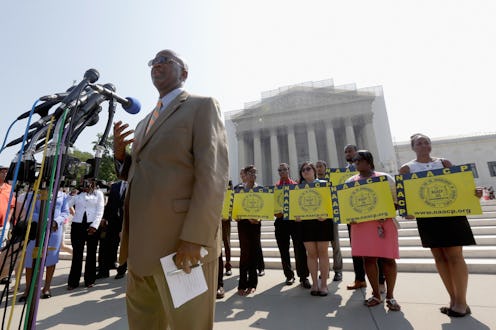News
The NAACP Has Been Targeted Many Times Before
In what appears to be an attack on civil rights group NAACP, an explosive device detonated outside the Colorado Springs branch's headquarters on Tuesday. Luckily, nobody was killed or injured in the attack. The FBI is looking for the alleged attacker, described as a balding white man driving a white pickup truck. Unfortunately, this is not the first attack that has been waged at the well-known group; the NAACP has a history of violent attacks on its leaders and facilities, perpetrated by white supremacist figures that were sometimes linked to larger organizations.
Although the Colorado Springs bomber's motives are not yet known, it is, as always, hard to believe that any attack on an organization dedicated to securing the rights of African-Americans would be targeted by anyone without hateful motivations.
In this instance, no lives were taken. And though that's a positive, it doesn't imply that fatalities weren't intended. In fact, the attack evokes a common tactic used against the NAACP in the Jim Crow era, in which churches, communities, and individuals were targeted. It's horrible to say that in 2015, we're still seeing the same hate toward an organization that has promoted positive change in our nation in its 100-year existence.
Here's an unfortunate overview of previous attacks on the NAACP. This is by no means comprehensive, because unfortunately many of the bombings and attacks that have rocked the organization have faded into history. These, however, are a just a few of the egregious wrongdoings.
Harry T. Moore
Moore founded the Brevard County NAACP in 1934 building the Florida arm of the organization and eventually becoming the executive secretary of the group's Florida State Conference. Moore became heavily involved with a rape case in Groveland, in which four black men were accused of raping a white woman. Sheriff Willis McCall was transporting two of the defendants, Sammy Shepherd and Walter Irvin, when he allegedly pulled them both out of the car and shot them, killing Shepherd and critically wounding Irvin. Moore called for the sheriff's suspension and a murder indictment.
Six weeks after the shooting, on Christmas Day 1951, Moore was killed when a bomb was placed under his bed. Despite multiple investigations, Moore's murder was never solved. He was the first NAACP-linked victim of such an attack.
Rev. Fred Shuttlesworth
Rev. Fred Shuttlesworth was the membership chairman of the Alabama chapter of the NAACP in 1956, the year the state outlawed the group. But Shuttlesworth continued his work, filling the void that was left by the NAACP's absence. Shuttlesworth was a key figure in the Birmingham campaigns in the civil rights movement, working with Martin Luther King, Jr. to organize protests.
Shuttlesworth was beaten in the streets when he and his wife attempted to enroll their children in an all-white school in 1957. In 1958, his life was spared when a church member spotted a bomb and moved it away from Shuttlesworth before it exploded.
Thankfully, Shuttlesworth survived both of these attacks and continued on as a civil rights leader until he died in 2011.
Medgar Evers
When his application to a segregated school was denied in 1954, Medgar Evers became the central focus of an NAACP campaign to desegregate the University of Mississippi Law School. Later that year, Evers was named the group's first Mississippi field officer. Evers was a crucial figure in the eventual desegregation of the University of Mississippi in 1962, but his work sparked many threats against him. He had a Molotov cocktail lobbed at his home, and, five days before his death, he was nearly run down by a motorist as he exited the Jackson NAACP office.
Just hours before JFK's national speech on civil rights in 1963, Evers was shot in front of his home. His killer wouldn't be convicted until 30 years later. He was buried at Arlington National Cemetery with 3,000 people gathered to mourn him. His wife, Myrlie Evers-Williams, went on to serve as the chairman of the board for the NAACP.
1989
There was a horrible string of attacks against the NAACP as late as 1989. That year, a teargas bomb was mailed to the Southeast regional office of the NAACP in Atlanta. Most of the office's staff was at lunch when the bomb went off, but eight people had to go to the hospital with respiratory problems. In July of that year, the windows at the Baltimore national office of the NAACP were destroyed by a high-power rifle. NAACP attorney Robert E. Robinson was killed by a mail bomb that year. It eventually was discovered that Walter Leroy Moody, Jr., the same man responsible for killing judge Robert Vance, had also killed Robinson.
Images: Wikimedia Commons
